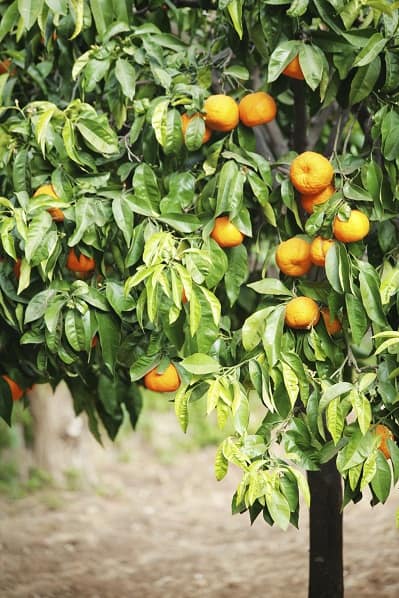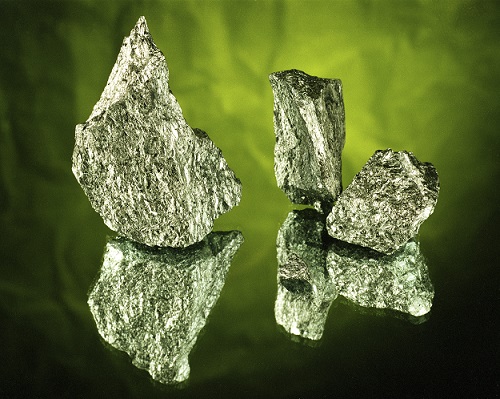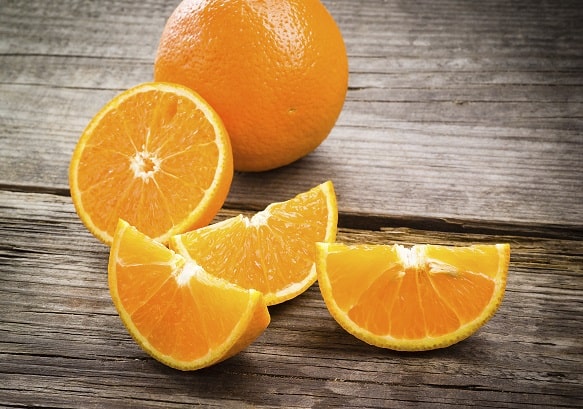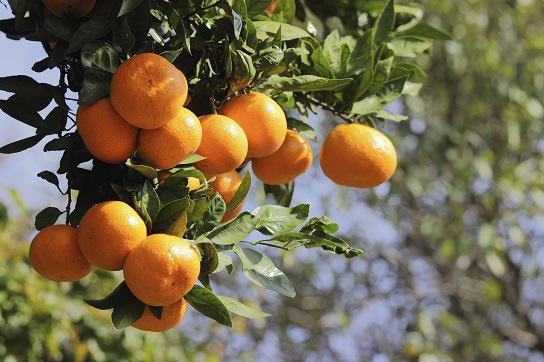 It’s no secret these days that oranges are a healthy food. In fact for the government and their endless quest to get us to eat healthily, oranges are something of a miracle because they are both extremely healthy and delicious…
It’s no secret these days that oranges are a healthy food. In fact for the government and their endless quest to get us to eat healthily, oranges are something of a miracle because they are both extremely healthy and delicious…
…but the problem is that while these reports do convince people about the qualities of oranges, it is almost always orange juice that they end up buying. They hardly ever buy real oranges because they mistakenly believe that peeling an orange is too inconvenient.
Supposedly 90% of Florida’s oranges go towards making juice rather than ending up straight on people’s plates…
…and that’s a big problem because for your health, and especially for your acne, real oranges beat the juice version hands down.
To put it simply, I never recommend an acne to patient drink orange juice over the real fruit. Orange juice does contain some vitamin A, the second best vitamin ever for acne, and plenty of acne-friendly vitamin C, which is how the marketing masterminds have got everybody drinking it…
…but like all fruit juices, the vast amounts of sugar orange juice contains outweighs any advantage for your acne. A single cup of orange juice contains 21 grams of sugar, compared to a regular orange containing 10 grams. That’s only an unsweetened version too; more processed versions from the grocery store might have 30 grams, or even 40.
Far from the nutritious drink you may have been led to believe, orange juice is more like drinking a sugar supplement flavoured like oranges with a few added vitamins. Orange juice will first give you the traditional acne-causing effects from sugar, most notably inflammation. Then orange juice can also increase your level of insulin resistance, and that means more oily skin and more acne.
Orange juice causes blocked pores via fatty liver disease
The problem is that about 50% of the sugar in orange juice is fructose, which is processed completely differently to glucose. A healthy body converts dietary fructose into glycogen inside your liver, a form of fuel, and then stores it ready for use.
However this process doesn’t happen correctly with orange juice, for two reasons. 1) There is absolutely tons of sugar in orange juice, and 2) all the fiber in orange juice is usually destroyed. Usually, the fiber in oranges slows down the absorption of fructose, but when there’s none, so much sugar hits the liver so quickly that it cannot process it properly. It converts some to glycogen, but the rest gets converted to fat and stored within the liver.
Gradually this fat takes up a greater and greater part of your liver. Importantly for acne patients, this causes your liver’s ability to recognise insulin to be impaired. Insulin is needed to shuttle fuel around the body and into cells, including the liver.
Read Annihilate Your Acne – get the ultimate diet for clear and glowing skin!
With a fatty liver, your body needs more insulin to store the same amount of fuel in a liver cell, so what does your body do to compensate? It pumps out higher and higher amounts of insulin. Your insulin is constantly elevated, and that leads to increased sebum production, blocked pores, p.acnes bacteria and a greater opportunity for acne to be born.
The whole condition described above is known as non-alcoholic fatty liver disease, and it’s one that’s becoming extremely common these days.
The main issue is that our average sugar consumption has skyrocketed over the last century to about 175 grams a day in America. That’s absolutely enormous seeing as the safe limit is 50 grams, and seeing as a serving of strawberries, broccoli, and kale would only see you reach under 10 grams.
Doctors even report that increasing amounts of kids have the symptoms of a fatty liver. Until the last decade it was a condition mostly found in middle aged men and women. The culprit is soft drinks, endless candy bars, and almost certainly the juice of oranges.
Orange juice contains heavy metals
The sugar isn’t the only acne problem with fruit juice either; many types including orange juice are contaminated with arsenic, a heavy metal found in the earth’s crust.
Arsenic is a highly carcinogenic (cancer-causing) substance, so the American FDA sets a limit of 10 parts per billion (10ppb) on its level in water. However they don’t bother to control its levels in other drinks and foods.
Important article – the top 6 vitamins and minerals for clearing acne
Those foods are nevertheless being analysed, and the results have shown that fruit juice routinely exceeds the safe limit of 10ppb. Apple juice is the worst, with an average of over 23ppb, which is the level where negative health effects begin to show up.
However, just about every fruit juice contains too much arsenic for acne patients…
Therefore I would already recommend against orange juice just for the health problems that arsenic causes, but it’s extremely important for your acne too. One of the classic symptoms of arsenic poisoning is hyperkeratosis. That’s a condition where your skin produces too much keratin, a protein in your skin which binds the cells together and keeps them tough and hardy.
Hyperkeratosis causes your dead skin cells to stick together, form massive clumps and then get lodged firmly in your pores. Combine that with the high sebum production that most acne patients already have, and you have a sure-fire recipe for blocked pores.
That in turn provides the perfect environment for p. acnes bacteria to breed and acne to form. It’s basically a nightmare scenario for your acne but you can easily avoid it by avoiding the vast majority of fruit juice from oranges, apples, or whatever. Arsenic is not an especially common problem for acne patients, but one study showed that fruit juice drinkers have particularly high levels in their body.
Apple juice drinkers had around 19% more than average, with grapefruit juice drinkers having around 20% more. The juice of oranges was not mentioned, but based on the results of the other fruits I cannot recommend that you drink it…
…and what’s more, judging by the evidence we have, it seems that arsenic may be the tip of the iceberg. There’s one fungicide formerly used on orange juice called carbendazim. This chemical was banned by the FDA long ago due to it causing infertility and destroying the testicles of lab animals. Modern orange juices are supposedly free from carbendazim…
Why bread and pasta are a massive cause of acne
…bur products imported from other countries where they are laxer on safety, including Brazil, still contain low levels. Could other pesticides still be present, and possibly other banned ones? It’s possible.
Why does this matter anyway? Because chemical exposure in foods and cosmetics is one of the great hidden causes of acne.
Heavy metals like arsenic and mercury, and chemicals like carbendazim and other pesticides can all cause inflammation and deplete vital acne antioxidant levels. They’re so overlooked that in my eBook Annihilate Your Acne, I devoted a 10 page chapter to them.
Orange juice is old and nutritionless
 Finally, a significant amount of commercial orange juice is stored for over a year before it’s actually sold. Over time the various acne nutrients and compounds in the juice degrade. By the time it is ready to be packed off and shipped to supermarkets, the classic flavour of oranges has all but disappeared.
Finally, a significant amount of commercial orange juice is stored for over a year before it’s actually sold. Over time the various acne nutrients and compounds in the juice degrade. By the time it is ready to be packed off and shipped to supermarkets, the classic flavour of oranges has all but disappeared.
To restore the lost appeal the manufacturers add various flavour packs. The primary ingredient is ethyl butyrate, which tastes remarkably like oranges and is fairly harmless, but it’s not the only chemical involved. Succeeding in finding out what these ingredients actually are seems to be impossible unless you’re an industry insider. I never recommend that you eat a processed food unless you know exactly what the ingredients are, so for that reason I can’t recommend commercial orange juice for acne patients either.
The basic theme of this is that the orange juice you buy in the shops is not simply some nutritious, acne-friendly oranges coverted to juice form.
The juice is full of additives, the arsenic is a problem, and the very fact that it’s a juice and has all the fiber of oranges removed makes the sugar content a lot more deadly for your acne.
Important article – the top 7 natural topical treatments for acne
The good news is that if you’re suffering from the problems of excessive fruit juice consumption, then they are fairly simple to reverse. A fatty liver is reversible in all but the most serious cases, and basically, if your’s wasn’t reversible, you’d probably be in the hospital right now. Many informed citizens are also beginning to recognise fruit juice for the junk it really is; in 2013 sales of fruit juice reached their lowest levels for 15 years.
Overall I think we may have passed the peak of love for orange juice and fruit juice in general, but massive sugar consumption is still a big problem, for both health and acne worldwide. Sugar has stealthily invaded almost every type of food on the market; even breaded fish contains sugar now. If you don’t take special care with your diet you are guaranteed to unknowingly eat one sugar source after another, until your face is full of acne and you have no idea why.
Fortunately you can get informed by reading this article here, which gives you all you need to know about avoiding sugar specifically to cut acne.
Orange fruits are packed with vitamin C
For now, remember that orange juice is only acceptable to drink occasionally, not on a regular basis. The nutrients like vitamin C and iron can have benefits for your acne, however that’s no reason to drink it…
…because actual oranges are just as rich in beneficial compounds for acne as the juice is.
In fact real oranges are just about healthier for acne patients in every way. The orange has greater amounts of acne nutrients, it has less acne-causing sugar, and more beneficial compounds due to them not having spent a year degrading. A medium sized portion of oranges (1 medium orange) contains just 10 grams of sugar, less than half that of a cup of orange juice.
At the same time, the sugar only causes a fraction of the acne because of the large amount of fiber in oranges. This slows down the absorption of the sugar from oranges and that allows your liver to process it at its own preferred pace. It also leads to less inflammation, less messing up of your body’s acne nutrients, less damage to your body’s intricate system, etc.…
…and not only do regular oranges not have many acne problems, but oranges are also just as rich in vitamin C as they are famously given credit for. Oranges, which are actually a member of the berry fruit family, contain roughly 100% of the recommended daily allowance per 110 grams, or a medium sized orange. Only berries such as the strawberry can match that out of the commercially sold fruits, which makes sense seeing as oranges are the world’s largest commercial berry fruit.
Back in the eighteenth century, sailors all over the world were falling victim to the life-threatening condition known as scurvy. Captains on long voyages despaired as their men first developed mood swings and spotted limbs, and then later became dizzy, developed gum disease, and eventually died. However one day a medical officer on board put two and two together and realised that nobody who ever ate oranges got scurvy. From that day forth, just about every smart captain of a long haul journey would bring a crateful of oranges with them, and slowly scurvy faded to a distant memory.
How did oranges achieve this? Oranges achieved this because scurvy is nothing more than an extreme case of vitamin C deficiency. Oranges are clearly a great source of vitamin C in reality rather than just in theory.
Why zinc is the number one supplement for red and inflamed acne
For your acne that means that you can benefit from 1) increased healing of your older acne, 2) reduced levels of stress hormones like cortisol, and 3) stronger and more inflammation resistant skin due to higher levels of its structural protein collagen. Vitamin C is one of the greatest acne nutrients around and eating oranges is one of the best ways to get it from food.
Therefore like just about any vitamin C rich food, all this makes oranges a great food to eat if you are stressed out, or are simply looking to boost your daily nutrient intake.
Oranges have hidden medicinal compounds
 The best news is that oranges have tons of other advantages too. By far the biggest of them is the ability of oranges to detoxify excessive estrogen levels from your body. Having too much estrogen leads to a condition called “estrogen dominance”, basically where your estrogen is so high that it overpowers your progesterone levels.
The best news is that oranges have tons of other advantages too. By far the biggest of them is the ability of oranges to detoxify excessive estrogen levels from your body. Having too much estrogen leads to a condition called “estrogen dominance”, basically where your estrogen is so high that it overpowers your progesterone levels.
This condition is particularly important for women because it increases an enzyme called 5-alpha reductase in your body. What that does is convert testosterone to DHT in your body, meaning that your DHT levels increase. That’s a nightmare for your skin because DHT is one of the biggest acne-causing hormones in the business.
Basically, the whole estrogen-dominant scenario plays out like this: your estrogen gets too high, your progesterone is then forced downwards, this lack of progesterone causes more DHT to be manufactured from testosterone in your body, the excessive DHT stimulates sebum production, your pores get blocked, and acne is born.
The connection between estrogen dominance and acne is indirect but very tight. This is particularly problematic for women because they are simply not designed to have high levels of androgens (male hormones such as DHT and testosterone). Compared to men, it takes very little extra DHT for a woman’s sebaceous glands to be turned up to full acne-causing mode.
It’s basically a nightmare situation that will almost inevitably lead to oily skin and a face full of acne, but the good news is that the problem is easy to treat, in most cases.
Read this article for the full estrogen/acne connection
Certain foods can detoxify excessive estrogen from your body, and oranges happen to be one of them. Oranges and also nectarines, satsumas, and clementines contain tons of different substances that can normalise high estrogen levels; there’s naringenin, there’s d-limonene, quercetin, hesperidin…
…and the most powerful out of all of them is calcium d-glucarate. This is found in various different foods but particularly broccoli, apples, berries, and oranges. Studies have been done on calcium d-glucarate and the conclusion has been simple: calcium-d glucarate significantly ramps up the body’s ability to detoxify unwanted oestrogens.
Aside from the studies done specifically on the estrogen side of things, there’s also a ton of studies showing that calcium-d glucarate can put a halt to the growth of cancer cells. Excessive estrogen is a highly likely cause of several cancers, most notoriously breast cancer, so that provides further evidence that the substance is good for sorting estrogen out.
The best news is that out of all the foods that scientists have tested for calcium d-glucarate, oranges are the best source by far. Add that to the other compounds and it becomes clear that oranges are an estrogen-reducing juggernaut. Then combine that with the vitamin C and you have an excellent acne curing food.
I would hesitate to say that oranges belong in the top tier of acne-curing foods. Oranges do have those two standout features, but it doesn’t have anything particularly unique, not like the watermelon and its wound healing properties.
Nevertheless, the two properties oranges do have are both very powerful for clearing your skin. If you’re a particular fan of oranges then your favourite snack should be paying off well for you.
Oranges – the tip of the iceberg
There are tons of different citrus fruits flooding the market, but according to the nutritional data, oranges are actually the very best one for your acne. Mandarins (or nardicotts) are the weakest as they only contain about half of the vitamin C that an orange does.
The clementine, on the other hand, contains less than an orange but far more than the mandarin, so I’d say that they’re at least in the same league for clearing acne as oranges are. The good news is that every citrus fruit, oranges, satsumas, nectarines, or clementines, will provide you with at least some acne benefits.
If you live in some obscure village that only sells satsumas, there’s no need to worry. If you want to experiment with flavour and taste, you have a ton of interesting opportunities.
Do oranges have acne causing side effects?
 The only real problems that oranges are able to cause are allergies. A disproportionately large amount of people are allergic to oranges, compared to almost any other fruit. The basic nature of an allergy is that your body targets a normal food and treats it as a threat, despite it posing no harm.
The only real problems that oranges are able to cause are allergies. A disproportionately large amount of people are allergic to oranges, compared to almost any other fruit. The basic nature of an allergy is that your body targets a normal food and treats it as a threat, despite it posing no harm.
For example, your body might mistakenly believe that the citric acid in a lemon is a threat. This triggers the release of a ton of inflammatory chemicals like histamine, and they create all the allergic reactions that we know and love. The chemicals can give you a runny nose, they give you a crippling headache, they can give you fever…
…and what they can also do is act just like any other inflammatory chemical your body releases, and that means that they can make your acne significantly worse. Allergic reactions trigger the release of so many chemicals that they can make your acne redder, far more painful and far more swollen. That’s why internet acne forums are full of people with unbelievable sounding stories of individual foods, including oranges, breaking them out. It doesn’t mean that the food is an inherently bad one for acne, instead it means that the user is allergic to it.
Therefore if you notice that your acne does get worse after eating any oranges, you are highly likely to be allergic to a specific compound in it.
Some might argue that the FODMAPs in oranges are to blame. FODMAPs are types of poorly digested small chain carbohydrates that cause bloating and indigestion in some people, symptoms that commonly manifest as acne. They’re a classic cause of unexpected pimple outbreaks in healthy fruits and vegetables. But oranges are low in most types of FODMAPs, and are usually prescribed on the low FODMAP diet. Some other compound is clearly responsible.
Remember that not every allergic reaction has to be a horror that confines you to your bed or swells up your throat and puts you at risk of death. Cystic acne seems to be particularly common with oranges.
The good news is that as is always the case with allergies, only a select few people will react badly to oranges and it will almost certainly NOT give you acne. Factor in the low sugar, and we can safely say that oranges don’t have any acne-causing problems lurking in them.
Conclusion – oranges have strong acne-clearing powers
Oranges are an excellent food for clearing your acne, due to being a classic vitamin C food and also having the little known ability to regulate estrogen levels. Those advantages allow oranges to improve the healing of your old acne, make your skin stronger, and significantly reduce your sebum production.
I wouldn’t say that oranges are the best fruits for acne in existence; if you were to pick only the very healthiest fruits on offer then the strawberry or watermelon would both be better than oranges.
Nevertheless the orange is still a great fruit for what it is. Just say no to the juice! Orange juice is like a sugar supplement, with a little vitamin C for health and a little arsenic sprinkled on top.
If you drink the juice of oranges for convenience, then try one of the numerous other citrus fruits instead. Oranges are the best for acne of them all but fruits like clementines are significantly easier to peel and are very nearly as acne-friendly.
NEXT: learn the root causes of acne, clear your skin permanently
Thanks for reading!